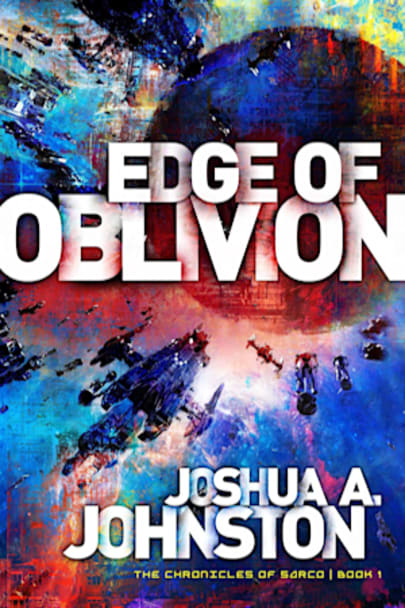A Forgotten Past. A Terminal Future.Earth has emerged from a cataclysmic dark age with little knowledge of its past. Aided by the discovery of advanced alien technology, humanity ventures into the stars, joining other sentient races in a sprawling, prosperous interstellar Confederacy.That peace is soon shattered. Without warning, the Confederacy comes under attack by an unstoppable alien force … attack by an unstoppable alien force from the unknown regions. With hopes for civilization’s survival dwindling, Commander Jared Carter is sent to pursue an unlikely lead: a collection of ancient alien religious fragments which may—or may not—hold the key to their salvation …
more



Edge of Oblivion has it all – a big looming unstoppable threat, a race against the clock, a grand adventure that would do Indiana Jones proud, a range of developed and unique alien cultures and a great deal of mystery concerning the past.
The story opens with the arrival of Malum, a planet-sized object/entity of unknown origins that consumes planets and ships. It’s on course for an inhabited world, but it’s in no hurry. It will destroy all that lies in its path along the way. This creates huge stakes right off the bat. Malum reminded me of V’ger in Star Trek: The Motion Picture, or Unicron in the animated Transformers: The Movie. Really creepy.
Our hero is the captain of a minor confederacy starship. Rather than joining the battlefleet to fight a hopeless battle again Malum, he is sent in search of the fragments of an ancient alien parchment, belonging to a long-dead religious order. Seems the ink on the parchment is made from the same material as Malum’s hull.
This quest takes the crew to various exotic locations around the galaxy. On their travels, they find this religious order is not so dead as was thought.
This book kept me engaged and entertained all the way through. I’ve been on the search for a book that pushes the same buttons as Star Trek for me. Edge of Oblivion did this nicely. At the same time, it pushes all those Indiana Jones buttons. A wonderful blending of the sci-fi and adventure fiction genres.
The book comes to a big and satisfying conclusion, which still leaves scope for future stories, and plenty of remaining mystery to be uncovered. I’ll be reading the sequel the moment it comes out.
Behind all of this was a fascinating spiritual analogy. What C.S. Lewis did with fantasy in the Chronicles of Narnia, Joshua A. Johnston has done with science fiction. The result was really interesting.
Highly recommended.
While I had some difficulty getting into this novel and attaching to the characters initially, the story was tightly plotted and introduced enough questions to keep me reading. By halfway through, I was really enjoying the story. If you’ve never read space opera or much science fiction, this is probably not the place to start. But if you are already a fan of the genre, it is well worth the time to read!
An excellent cast of characters and sentient life-forms, this book brings to life other worlds effortlessly, with colorful and believable history. As a Star Trek fan, the highest complement I can give is that many times I was reminded of scenes on the bridge of Next Generation. The alien language is written so realistically. Into the Void is perhaps one of the best science-fiction, space adventures I have read.
Best of all, there is a hidden message in the book–belief in God is more powerful than the forces of darkness. But don’t worry; it’s not preachy at all! I would recommend this book to a secular audience as well, because the use of alien languages and history creates religions that are not Christian, but represent the power in the ONE GOD. Such good writing!